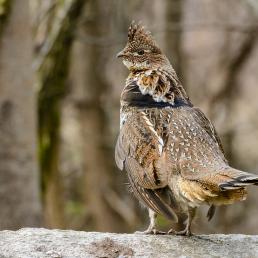

Join BirdNote tomorrow, November 30th!
Illustrator David Sibley and actor H. Jon Benjamin will face off in the bird illustration battle of the century during BirdNote's Year-end Celebration and Auction!
Why do birds consistently follow certain routes in their migrations? Pathways of migration evolved, shaped by the wind. During the height of the last ice age, ice-free breeding habitat for songbirds remained in what is now Alaska and parts of Western Canada. Studies of fossil pollen show that consistent winds blew across the continent on a NW:SE heading of 155 degrees. Scott Weidensaul recounts in his book Living on the Wind: “A powerful high-pressure center over central Canada pumped strong northwest winds, precisely the conditions that would aid migrants.” The birds rode these tailwinds to traverse the ice fields. And today, the birds still follow this bearing on their migration to South and Central America and the Caribbean.
Today's show brought to you by the Bobolink Foundation.
BirdNote®
Migration Routes Evolve
Written by Todd Peterson
This is BirdNote. [Sound of wind]
Why do birds consistently follow certain routes in their great journeys across the continents? [Sound of wind]
Pathways of migration evolved, shaped by the wind. During the height of the last ice age 18,000 years ago, much of North America was covered by glaciers. Yet ice-free breeding habitat for songbirds, [songbirds, breeding season, Western Alaska] such as the Blackpoll Warbler, remained in what is now Alaska and parts of Western Canada.[Song of Blackpoll Warbler]
Studies of fossil pollen found in muddy lake-bottoms show that consistent winds blew across the continent on a northwest-to-southeast heading of 155 degrees. As Scott Weidensaul recounts in his book Living on the Wind, “The ice cap produced a powerful high-pressure center sitting over central Canada, pumping strong northwest winds…precisely the conditions that would aid migrants on a 155-degree heading.”* The birds rode these tailwinds to traverse the vast ice fields. And today, although the continental glaciers have melted, the birds still follow this compass bearing on their way to wintering grounds in South and Central America and the Caribbean. Natural selection – and the vicissitudes of life on the wing – require that birds respond exquisitely to natural conditions. Their lives depend on their attunement to the world around them, and particularly during migration, to the wind. [Sound of the wind]
Today’s show brought to you by the Bobolink Foundation. Find us on the web at birdnote.org.
###
Song of Blackpoll Warbler [163329] provided by The Macaulay Library of Natural Sounds at the Cornell Lab of Ornithology, Ithaca, New York, recorded by M. Medler. Songbird ambient breeding season in AK recorded by G. Vyn (ambient on Yellow-billed Loon track).
Producer: John Kessler
Executive Producer: Chris Peterson
© 2015 Tune In to Nature.org January 2015/2021 Narrator: Michael Stein
ID# migration-14-2013-01-10 migration-14




